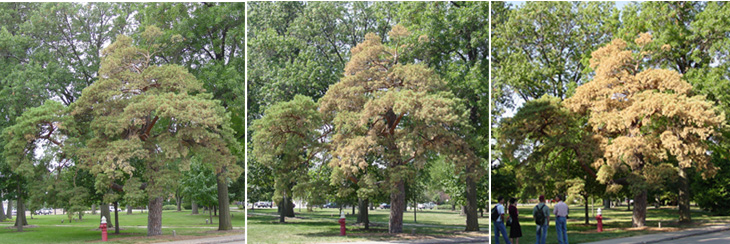Bursaphelenchus xylophilus
Pine Wilt Nematode

|
Aug. 20, 2003
|
Aug. 25, 2003
|
Sept. 2, 2003
|
Pine wilt disease progression- UNL East campus Scotch pine
|
(Description- Nickle, 1981)
Description of male: Spicules
large, uniquely arcuate, paired, with sharply pointed prominent rostrum;
distal ends of spicules with typical disc-like expansions. Tail
arcuate,
terminus pointed, appearing talon-like on lateral view, surrounded by short,
oval caudal alae. Seven caudal papillae, one adanal pair just pre-anal,
single papilla just pre-anal centered; two post-anal pairs just before
caudal alae origin.
Description of female: Lip region high, offset with six
lips. Stylet with small basal swellings. Esophageal glands
slender, 3-4 body-widths long, overlapping dorsally. Excretory pore
opposite junction of esophagus and intestine, sometimes at level of nerve
ring. Hemizonid conspicuous, about two-thirds body width behind medium
bulb. Ovary outstretched, oocytes usually in single file.
Post uterine sac long, extending three-fourths distance to anus. Tail
subcylindrical,
usually with broadly rounded terminus.
Diagnosis: B. xylophilus can be distinguished from
other species in the genus by the shape of the spicules, the distinct vulvar
flap and the lack of a digitate tail tip which is present in B.
mucronatus which we recognize as a valid species. One of us (YM)
tried unsuccessfully to mate B. mucronatus with B. lignicolus,
thus indicating their separate species status. B. fraudulentus
is
similar to B. xylophilus, but the female has a digitate tail tip
similar to B. mucronatus.
DNA Sequences Obtained
| Specimen |
Collected: |
| FCP-31 |
Falls City, NE |
| FCP-32 |
Falls City, NE |
Rapid wilting and death results from infestations of susceptible
pine trees by the pinewood nematode.
Pictures of trees
killed by pine wilt caused by B. xylophilus
The pine wilt disease was identified for the first time in the United
States in Columbia, Missouri in 1979. Since that first report, Bursaphelenchus
xylophilus has been found in 36 states, including all the Great Plains
states except for North Dakota. The widespread distribution of the pinewood
nematode suggests that it is native to the United States.
In North America, investigators have confirmed the disease on 27 species
of pinus (pine), one each of abies (balsam) and pseudotsuya
(fir), and two each of cedrus (cedar), larix (larch), and
picea
(spruce).
It is considered to be a potentially serious problem in landscape settings,
windbreaks, Christmas tree farms, and recreational plantings.
More information
on Bursaphelenchus xylophilus and Pine wilt disease




